
![]()
Search the Journey to Forever website – click HERE
|
Journey to Forever: Make a donation |
Navigation
Contact usTo Keith Addison Handmade Projects |
A Better Rat Trap
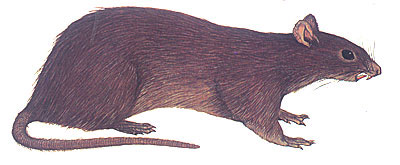
The rat problem
Traps
Predators
Prevention
Sonic repellants
Disposal
Rats and owls
Chinese rat trap
How to make a Chinese rat trap
Bucket rat trap
The rat problem
Rats are a menace and a worldwide scourge. City people think of them as disgusting creatures that infest sewers and spread disease, and that's true enough, but the real problem is what they eat, especially in farming areas. Cats are not effective, though they might seem to be. Cats don't kill many rats, if any, but they do frighten them away -- households with cats usually have no rats. But the problem isn't solved -- the rats simply move in next door where there's no cat.
... don't work. From a homesteader in the US: Compost dead rats, safe and sanitary and no putrescent smell to attract flies. See Composting
It's estimated that total crop losses caused by rodents, mostly rats, each year would be enough to feed 200 million people, nearly as many as the population of Indonesia. That's probably a low estimate, and post-harvest damage is about the same again.
In Southeast Asia rice crop losses due to rats are at least 15%: it's not unusual for farmers to report 15-30% losses, and losses can be as high as 50% or even 100% in a bad year.
In Indonesia, rats are the number one pre-harvest pest of rice, with about 17% of the harvest lost each year -- enough rice for 20 million Indonesians. In Laos, rodents are the second most important agricultural pest in mountainous regions, and the one over which farmers feel they have the least control. Rodents are one of Vietnam's top three agricultural problems.
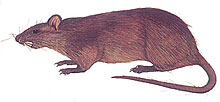
Bandicoot rat
Southeast Asian farmers now consider rodents (not insects, weeds or lack of soil fertility) to be the main factor limiting rice production.
Africa also suffers. In Tanzania, rats can eat more than 80% of the planted maize seeds in an area. During bad years rats have wiped out hundreds of square kilometres of maize, the country's staple crop, destroying 50% of the crop or more. All the African countries suffer. It is the same everywhere, on all continents. Losses of stored rice and maize are reported to be even more severe in Latin America.
In Pakistan, rats consume several million tons of stored wheat grain annually; in Bangladesh losses of grain stored inside houses are estimated at US$620 million a year, in houses only. In India, rats outnumber humans ten-fold. The United States has an estimated 1.25 billion rats and they cause at least $19 billion in damage a year. Worldwide, 3.5 million rats are born every day.
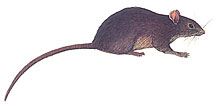
Black rat
The main culprits are the roof rat (Rattus rattus, also known as the black rat, ship rat, fruit rat, rice field rat, and by us as bamboo rats), the Norway rat (Rattus norvegicus, or sewer, barn, or brown rat -- pictured top of page, artwork by Karen Phillipps), more a pest in temperate regions than in the tropics, the bandicoot rat, a big Asian rat, and the house mouse (Mus musculus). One adult Norway rat eats 5 to 9 kg of grain a year, roof rats eat 3-4 kg a year, bandicoots 6-9 kg a year, and house mice 1 kg a year. With billions of rats in some countries, the losses are immense.
Rats also pose severe health risks. It was the black rat of East Asia that brought the Black Death (Bubonic Plague) to Europe, killing a third of the population. Plague is still a problem throughout the world today, with annual outbreaks in parts of Africa that kill hundreds of people.
Rats are closely associated with other diseases such as Leptospirosis and can rapidly spread other gastroenteric diseases such as Cholera and Salmonella. Recent research in Mozambique found that 18% of villagers tested positive for leptospira.
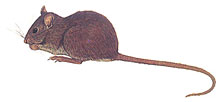
Buff-breasted rat (bamboo rat)
Contamination of water and food inside houses by rats is a serious health risk to rural people. In parts of Africa up to 10% of people are regularly bitten by rats while they're asleep, leading to secondary infections and rat bite fevers from bacteria entering the wounds. And rats contaminate stored grains with their urine and faeces, increasing the chance of disease.
Rats are clever, they're tough and very capable. And they breed all year around. Young rats reach sexual maturity at three months. A female rat will have as many as five litters a year, with up to 10 pups per litter, or more. This can mean frightening population growth. Local populations tend to swell along with the available food supply, and as the crops mature, swarms of rats appear to overwhelm the harvest.
Farmers often feel desperate, or just plain helpless in the face of such an onslaught.
The usual "control" method is to use poison, but it doesn't work very well. Smallholder farmers who can afford it use fast-acting, acute poisons like zinc phosphide. It's sold as a concentrate to be mixed with cereal bait and many farmers can't do it accurately or safely. The poisons are a threat to other species and to humans, and the rats quickly develop resistance to them.
Also, these rats are not dirty city sewer rats, they're wild animals living mainly on grains and fruit and they're a major source of protein food in many 3rd World areas -- not much different to rabbits. Using poisons to control them can lead to less food, not more. There's growing demand in many 3rd World countries for effective rat controls that don't rely on poisons.
The best answer, if not the only answer, seems to be to use a combination of traps and natural predators.
Traps
 Trapping, to be effective, requires a better trap than most. There are very many different types of rat traps, but few of them work well. We found one that works very well indeed. We've caught many hundreds of rats with these traps, probably thousands (we lost count). They never failed, they're perfectly safe to use, and they're simple and easy to make at village level.
Trapping, to be effective, requires a better trap than most. There are very many different types of rat traps, but few of them work well. We found one that works very well indeed. We've caught many hundreds of rats with these traps, probably thousands (we lost count). They never failed, they're perfectly safe to use, and they're simple and easy to make at village level.
This is the wire-cage spring-door live trap used in South China. Here's how it works, and here's how to make one.
How to Make Springs -- online book, written "for the benefit of someone who has (or can gain access to) basic hand and power tools". Arranged in logical order presuming minimal knowledge of the metalworking trades or of springmaking, cross-linked to provide a forward path through the entire manufacturing process.
http://home.earthlink.net/~bazillion/intro.html
Here's a different kind of trap, from Zimbabwe -- a bucket trap. We haven't used this one, but there are good reports of its use from Africa and India. Again, totally simple and anyone can make one.Predators
The cats at the Beach House, our headquarters in Hong Kong, were completely useless, though the place was overrun with bamboo rats coming down from the hillsides.
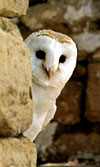
Barn Owl Centre, Gloucestershire
Dogs aren't much use either. Nibbles, the Beach House dog, loved chasing rats, but she was much too smart ever to risk actually catching one -- cornered rats are vicious. (She chased the cats too, and never caught them either.) (But she was great at catching fish.) Terriers might be useful around the house, but the real answer is owls. A pair of barn owls with five chicks will eat at least 3,000 rodents in one breeding season, and you can have lots of pairs. They're found all over the world, and it's easy to attract them. See Rats and owls.
Prevention
You can't rat-proof the crop, but you can go a long way towards rat-proofing homes, and especially grain stores. Rats eat their way through wood, and even soft metal. They often chew through electrical wiring, creating a fire hazard. They can fit through much smaller gaps than you'd think. They're excellent climbers (other than bandicoots) and good swimmers. A Nordic rat can jump 30 inches straight up (77 cm).

Traditional grain silo at Korhogo on the Volta River.
Bandicoots and Nordic rats burrow right under floors, sometimes collapsing them. Black rats infest roofs (that's why they're called roof rats). Villagers with thatched-roof homes find it really helps to renew the thatch every year -- thatch, palm or nipa roofs are a haven for black rats (use the old thatch for mulch in the orchard).
It helps to keep the place clean and tidy, free of rubble or empty containers where rodents might nest, and free of food scraps, pet food, poultry feed, etc. that might attract them. Have a clear strip round buildings kept free of vegetation. Lop off overhanging branches.
Fit hard metal strips to the bottom edges of wooden doors and their frames, wire netting screens to windows, steel rat guards to drainpipes (one metre above the ground).

Horreos traditional corn cribs in Galicia, Spain.
Grain storage techniques -- Evolution and trends in developing countries, FAO Agricultural Services Bulletin No. 109, Rome, 1994, Chapter 9 - Rodent control: Control of rodent pests (ignore the stuff about poisons):
http://www.fao.org/docrep/T1838E/T1838E1l.htm#Control of rodent pests
Traditional grain store in Japan
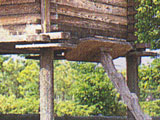

Sonic repellants
"Hubby bought those -- we still have the mice, and ants. So if anyone would like me to mail you one to try I would be more than happy to do so!! Just please don't mail it back!!"
We had a similar experience (we got our money back). This sums up the expert consensus:
"There is NO device, that is sonic, electric or magnetic, or any combination of these, that has ever been scientifically proven to keep any animal or insect at bay. They don't work. They don't work for any kind of animal."
http://UnExCo.com/spoofs.html#sonicDisposal
A better rat trap
Rats and owls
Chinese rat trap
How to make a Chinese rat trap
Bucket rat trap
Appropriate technology
Appropriate technology resources
- Agriculture resources
- Wood resources
Blacksmithing
Wood fires that fit
Houses that fit
Water-powered water pumps
Journey to Forever and AT
- Chinese watering cans
- Handmade Projects watering can plans
- Hoe for victory!
- Billhooks and sickles
A better rat trap
- Rats and owls
- Chinese rat trap
- How to make a Chinese rat trap
- Bucket rat trap
Appropriate technology subjects